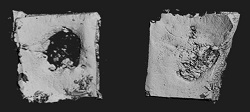 |
| Before and after use of the DNA-delivering patch, bone is regenerated to regrow missing skull.--Courtesy of University of Iowa |
A small patch that delivers DNA-loaded nanoparticles may be the next step in bone regeneration, offering a new option for patients currently receiving repeated, painful injections.
In animal tests at the University of Iowa, the patch delivered genetic material that codes for the platelet-derived growth factor PDGF-B, which stimulates cell production, and it regrew enough bone to cover skull wounds.
The patch itself is composed of a collagen scaffold loaded with synthetically created plasmids with the DNA. By placing the patch on a small area of skull, the plasmids are able to infiltrate surrounding bone cells and spur growth to replace what had been broken or missing.
The patch, which works nonvirally, could be used to rebuild bone for dentistry and dental implants or to regenerate bone in the head or face of those suffering from birth defects, the team published in the journal Biomaterials.
"We delivered the DNA to the cells, so that the cells produce the protein and that's how the protein is generated to enhance bone regeneration," lead author Aliasger Salem of UI said in a statement. "If you deliver just the protein, you have to keep delivering it with continuous injections to maintain the dose. With our method, you get local, sustained expression over a prolonged period of time without having to give continued doses of protein."
The scientists hope to continue the studies by creating a similar method to spur blood vessel growth in the bone, leading to even more fully realized bone regeneration.
- here's the University of Iowa report
- and the research abstract